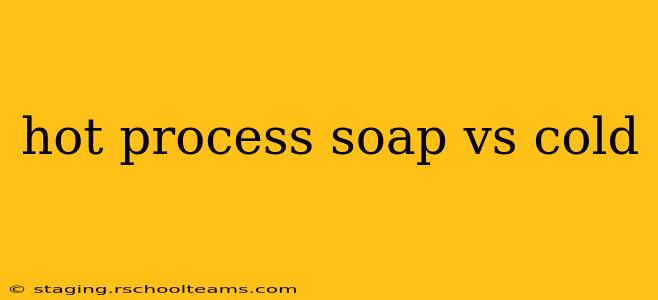Making soap at home is a rewarding experience, offering a creative outlet and the satisfaction of crafting a product tailored to your preferences. However, the choice between hot process and cold process soapmaking can seem daunting. This comprehensive guide explores the key differences, advantages, and disadvantages of each method, helping you choose the best approach for your needs and skill level.
What is Cold Process Soapmaking?
Cold process soapmaking is the most traditional and popular method. It involves combining oils and lye (sodium hydroxide) at room temperature. The chemical reaction, known as saponification, generates heat, but the soap mixture remains relatively cool. The mixture is then poured into a mold and allowed to cure for several weeks. This curing process allows excess water to evaporate, hardening the soap and completing the saponification process.
Advantages of Cold Process Soapmaking:
- Gentler on the skin: The longer curing time allows for more complete saponification, resulting in a milder soap that's often better for sensitive skin.
- More design flexibility: Cold process soapmaking allows for a wider range of colors, additives, and embellishments. Intricate designs and swirls are easily achieved.
- Unique character: Cold process soaps often develop a unique character and appearance during the curing process, making each batch slightly different.
Disadvantages of Cold Process Soapmaking:
- Longer curing time: Cold process soaps require a minimum of 4-6 weeks of curing time before they are ready to use.
- More hands-on: The process involves more steps and requires more attention to detail, especially regarding safety precautions with lye.
- Potential for variations: Due to the longer curing time and the influence of external factors like temperature and humidity, consistency can be challenging to achieve across batches.
What is Hot Process Soapmaking?
Hot process soapmaking accelerates the saponification process by heating the soap mixture. This can be done using a double boiler, crockpot, or other methods that maintain a consistent temperature. The soap cooks until it reaches a "trace," a stage where the mixture thickens slightly and resembles pudding. This cooked soap is then poured into molds and allowed to cool and set. Hot process soaps typically require less cure time than cold process soaps.
Advantages of Hot Process Soapmaking:
- Faster curing time: Hot process soaps usually require only 24-48 hours to cure, or even less, making it a much faster process than cold process.
- Less hands-on: Although initial preparation is similar, the cooking process requires less active monitoring once the heat is applied.
- More consistent results: The controlled heating process contributes to more consistent results from batch to batch.
Disadvantages of Hot Process Soapmaking:
- Can be harsher on the skin: While the saponification process is complete, the faster cooking time may leave behind trace amounts of lye, potentially leading to a harsher soap for sensitive skin.
- Limited design flexibility: The high temperatures and faster process can melt or damage delicate additives and make it more difficult to create intricate designs.
- Less interesting aesthetic: Hot process soaps often have a more uniform, less visually interesting appearance compared to cold process soaps.
Which Process is Right for Me?
The best soapmaking method depends on your priorities:
- Choose cold process if: You prioritize gentle soap, have more time for a longer curing process, and want creative design flexibility.
- Choose hot process if: You need faster results, want more consistent batches, and aren't as focused on intricate designs.
How long does hot process soap take to cure?
Hot process soapmaking drastically reduces curing time. While cold process soap needs several weeks, hot process soap typically requires only 24-48 hours, sometimes even less, before it's ready to use. However, a few days of additional curing will improve the soap's hardness and mildness.
Is hot process soap harder than cold process?
Generally, hot process soap can be slightly harder than cold process soap due to the accelerated saponification process removing more water content during cooking. However, this difference isn’t always significant and depends on the specific recipe and ingredients used in both methods.
What are the benefits of hot process soapmaking?
The main benefits of hot process soapmaking are speed and consistency. The accelerated saponification leads to a much quicker turnaround time, making it ideal for those seeking faster results. The controlled heating process also contributes to more consistent results from batch to batch.
Is hot process soap better for beginners?
Hot process soapmaking is often considered more beginner-friendly because of its faster cure time and less stringent requirements for precise temperatures and timing. However, both methods require careful attention to safety procedures with lye. Always prioritize learning proper safety measures before attempting either method.
Whether you're a seasoned soapmaker or a curious beginner, understanding the nuances of hot process and cold process methods empowers you to create soaps that meet your specific needs and preferences. Remember safety first, and always research thoroughly before embarking on your soapmaking journey.
